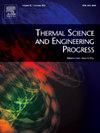考虑多组分影响的排气系统优化设计与分析
IF 5.1
3区 工程技术
Q2 ENERGY & FUELS
引用次数: 0
摘要
航空发动机排气系统的设计既具有优异的气动性能,又能有效地抑制红外辐射,这对于推进军事技术的发展至关重要。本研究通过关注包含涡轮和加力燃烧室影响的排气系统,解决了飞机发动机各部件之间复杂的相互作用。利用商业流场计算软件和离散传递法评估红外辐射强度,采用分层优化策略。该策略针对4个结构设计变量和5个红外涂层变量,详细分析了它们对气动性能和红外特性的影响。通过应用主效应关系和控制变量法,深入研究其气动和热辐射特性,阐明其潜在的物理机制。与基准模型相比,该系统的流量系数提高了1.31%,推力系数提高了3.19%,0°红外强度降低了46.88%,30°、60°和90°角时的平均红外强度降低了17.31%。本文章由计算机程序翻译,如有差异,请以英文原文为准。
Optimization design and analysis of the exhaust system considering multi-component influences
The design of an aero-engine exhaust system that integrates superior aerodynamic performance with effective infrared radiation (IR) suppression is crucial for advancing military technology. This study addresses the complex interactions among various components of an aircraft engine by focusing on an exhaust system that incorporates the influences of both the turbine and afterburner. Utilizing commercial software for flow field calculations and the discrete transfer method for assessing infrared radiation intensity, the research employs a hierarchical optimization strategy. This strategy targets four structural design variables and five infrared coating variables, with a detailed analysis of their impacts on aerodynamic performance and infrared characteristics. Through the application of main effect relationships and the control variable method, the study delves into the aerodynamic and thermal radiation properties to elucidate the underlying physical mechanisms. The outcome is the development of a high-performance exhaust system that, compared to the baseline model, demonstrates a 1.31 % improvement in flow coefficient, a 3.19 % increase in thrust coefficient, a 46.88 % reduction in 0° infrared intensity, and a 17.31 % decrease in average infrared intensity at angles of 30°, 60°, and 90°.
求助全文
通过发布文献求助,成功后即可免费获取论文全文。
去求助
来源期刊

Thermal Science and Engineering Progress
Chemical Engineering-Fluid Flow and Transfer Processes
CiteScore
7.20
自引率
10.40%
发文量
327
审稿时长
41 days
期刊介绍:
Thermal Science and Engineering Progress (TSEP) publishes original, high-quality research articles that span activities ranging from fundamental scientific research and discussion of the more controversial thermodynamic theories, to developments in thermal engineering that are in many instances examples of the way scientists and engineers are addressing the challenges facing a growing population – smart cities and global warming – maximising thermodynamic efficiencies and minimising all heat losses. It is intended that these will be of current relevance and interest to industry, academia and other practitioners. It is evident that many specialised journals in thermal and, to some extent, in fluid disciplines tend to focus on topics that can be classified as fundamental in nature, or are ‘applied’ and near-market. Thermal Science and Engineering Progress will bridge the gap between these two areas, allowing authors to make an easy choice, should they or a journal editor feel that their papers are ‘out of scope’ when considering other journals. The range of topics covered by Thermal Science and Engineering Progress addresses the rapid rate of development being made in thermal transfer processes as they affect traditional fields, and important growth in the topical research areas of aerospace, thermal biological and medical systems, electronics and nano-technologies, renewable energy systems, food production (including agriculture), and the need to minimise man-made thermal impacts on climate change. Review articles on appropriate topics for TSEP are encouraged, although until TSEP is fully established, these will be limited in number. Before submitting such articles, please contact one of the Editors, or a member of the Editorial Advisory Board with an outline of your proposal and your expertise in the area of your review.
 求助内容:
求助内容: 应助结果提醒方式:
应助结果提醒方式:


